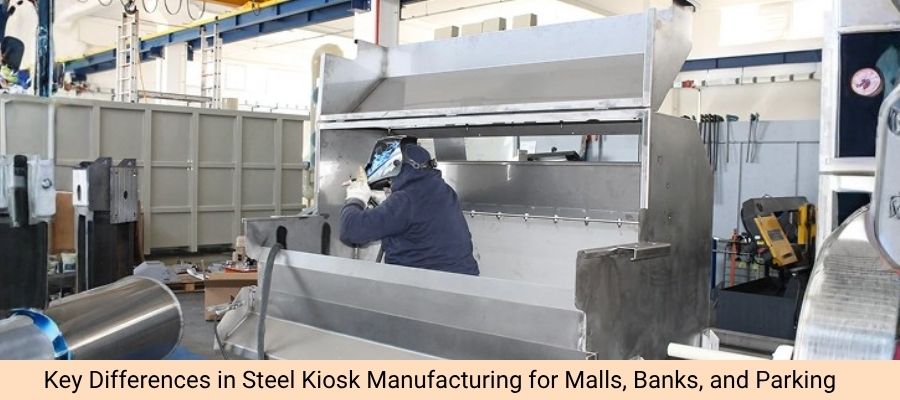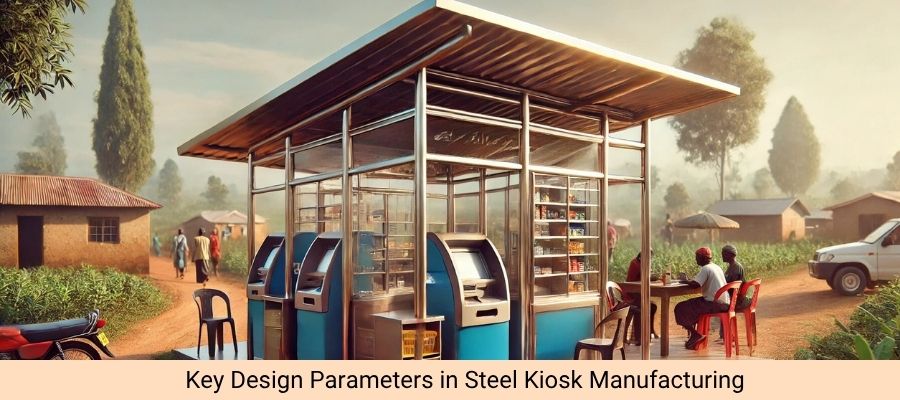Steel Kiosk Manufacturing Key Differences in Mall, Banking, and Parking Applications

Objective of the Article:
The aim of this article is to provide a comprehensive guide to understanding the nuances of steel kiosk manufacturing, particularly focusing on the key differences in design, functionality, and material requirements across various steel kiosk types. These include mall kiosks, banking kiosks, and parking kiosks, each serving unique purposes and environments.
This article aims to:
- Educate architects, fabricators, and business owners on the importance of tailored designs for different kiosk applications in malls, banks, and parking areas.
- Explain the structural and functional variations between kiosks used in retail, financial services, and public utility sectors.
- Highlight the significance of prefabricated steel kiosks, emphasizing their benefits in terms of durability, speed of installation, and modular design.
- Guide decision-makers in selecting the right kiosk type based on specific needs like security, aesthetic appeal, space optimization, and weather resistance.
- Assist businesses in understanding key customization options, safety considerations, and how to choose the right kiosk manufacturer or contractor for successful implementation.
By the end of this article, readers will have a clear understanding of how steel kiosks differ by use case and how to make informed decisions in designing, fabricating, and implementing steel kiosks for different commercial and functional needs.
In today’s urban and commercial landscapes, steel kiosks have become an essential component for enhancing business functionality and customer interaction. These prefabricated steel structures provide quick, cost-effective solutions for various sectors, ranging from retail and banking to public utilities like parking areas. As demand for modular kiosk designs grows, businesses, architects, and fabricators must understand the unique design, functionality, and material requirements across different applications. This in-depth guide aims to explore the key differences between mall kiosks, banking kiosks, and parking kiosks, shedding light on the diverse design, construction, and usage needs for each.
Introduction: The Growing Demand for Steel Kiosk Manufacturing in Urban and Commercial Spaces
The use of steel kiosks is rapidly transforming modern infrastructure in malls, banks, and parking areas across the world, including Uganda. These prefabricated kiosk units offer a range of advantages, including quick installation, durability, and modular design, making them ideal for urban settings where time and space are at a premium.
Steel kiosks are increasingly sought after in sectors such as retail, banking, and public utilities due to their versatility. For mall operators, kiosks provide a flexible retail solution, while banks and parking areas benefit from kiosks that offer a high level of security, weather resistance, and accessibility.
As the demand for modular kiosks grows, kiosk fabricators play a vital role in tailoring designs to meet specific functional needs, ensuring that these small but mighty structures serve their purpose efficiently and reliably.
What is a Steel Kiosk? Types, Structure, and Material Composition
A steel kiosk is a small, prefabricated structure made primarily from steel frames and cladding panels. It is typically used for various commercial, financial, or public utility functions, ranging from ticketing booths and ATM enclosures to small retail spaces in malls.
Key Components of Steel Kiosk Manufacturing:
- Steel Frames: Provide the primary support structure for the kiosk.
- Cladding Panels: Often made from galvanized steel, these panels protect against the elements while offering aesthetic appeal.
- Powder Coating: Ensures corrosion resistance and provides a durable finish.
- Insulation: Especially important for kiosks exposed to extreme weather conditions.
- Electrical Fit-Outs: Includes wiring, lighting, and outlets for functional operations.
Common Uses of Steel Kiosks:
- Shopping Mall Kiosks: Used for retail stands, information points, or quick-service stations.
- Banking Kiosks: Typically housing ATM machines or providing customer services.
- Parking Booths: Often used for toll booths or ticketing systems in parking lots.

Design Parameters in Steel Kiosk Manufacturing
Ergonomics and Accessibility:
Steel kiosk design must prioritize ergonomics to ensure ease of use for both employees and customers. In malls, kiosks often serve as retail hubs, requiring easy access to products and seamless customer interaction. For banking and parking kiosks, privacy, security, and user flow are critical design considerations.
Use of CAD and 3D Modeling:
Modern kiosk fabricators use CAD and 3D modeling software to create custom designs that optimize space, accessibility, and operational efficiency. This also allows for better visual appeal and helps ensure that the kiosk fits within the architectural constraints of malls, banks, or parking areas.
User Flow Differences:
- Mall Kiosks: Design focuses on retail functionality, where customers will interact with products, make purchases, and access services.
- Banking Kiosks: Requires designs with a focus on security, including ATM access, cash handling, and privacy for customers.
- Parking Kiosks: Must ensure that attendants or automated systems can easily manage vehicle transactions and direct traffic flow.
Shopping Mall Kiosks: Aesthetic, Space Optimization, and Brand Presentation
In a mall, a steel kiosk is not just a functional unit; it is also a branding tool. These kiosks must be both space-efficient and aesthetically pleasing to attract customers.
Key Features:
- Compact Design: Steel kiosks in malls are typically small but designed to maximize retail space. The use of modular kiosks allows for easy reconfiguration and relocation within the mall.
- Interior Lighting: LED lighting enhances visibility and product presentation.
- Branding and Display Shelving: Kiosks are designed to showcase products and brands, often with custom signage and display shelves.
- Glass Facades: In retail kiosks, glass is often used to create an open, inviting display area.
Location Planning:
The placement of kiosks inside a mall is crucial for maximum visibility and foot traffic, which directly impacts sales. Kiosk designers work closely with mall architects to ensure optimal positioning.
Banking Kiosks: Security, Privacy, and Durability in Steel Fabrication
Banking kiosks, whether for ATM machines or customer service points, require enhanced security features due to the sensitive nature of the services provided.
Key Design Features:
- Reinforced Steel Panels: Used to prevent unauthorized access and enhance physical security.
- Tamper-Proof Locks: These are critical for ATM kiosks, ensuring cash security and data protection.
- CCTV-Ready Enclosures: The ability to integrate surveillance systems into the kiosk design is essential for monitoring and security purposes.
- Weatherproofing: For outdoor banking kiosks, weatherproofing materials are essential to protect the electronic components from rain, wind, and UV exposure.
User Privacy:
Banking kiosks are designed to offer privacy for users while interacting with financial services, especially in public areas.
Parking Kiosks: Functionality, Weather Resistance, and Utility Design
Parking kiosks are crucial for managing the traffic flow and ticketing in parking areas. These kiosks are subjected to harsh weather conditions, requiring durability and functionality.
Key Features:
- Heavy-Duty Structure: Parking kiosks are designed to withstand the wear and tear of outdoor environments.
- UV Protection and Rain Resistance: Anti-rust coatings and durable materials protect kiosks from UV exposure and rain.
- Ticketing Systems: Kiosks often integrate ticketing systems, barrier controls, and communication interfaces to streamline parking operations.
- Compact Design: These kiosks are often compact, allowing parking attendants or automated systems to manage operations efficiently in limited space.
Structural Differences Between Mall, Banking, and Parking Kiosks
While all kiosks are made from steel, the structural specifications vary based on their intended use.
Comparative Analysis:
- Frame Thickness: Mall kiosks generally have a thinner frame structure due to their indoor use. Banking kiosks have reinforced frames for security, while parking kiosks require heavier, weather-resistant frames.
- Insulation: Mall and banking kiosks may have more extensive thermal insulation, while parking kiosks focus on weatherproofing.
- Load-Bearing Capacity: Banking kiosks may have more advanced electrical and data processing requirements, while parking kiosks prioritize equipment integration.
Electrical and Safety Considerations in Steel Kiosk Manufacturing
Steel kiosks are often equipped with electrical systems for lighting, security, and operational functions.
Electrical Systems:
- Wiring Layouts: Must be designed to meet local electrical codes and ensure the safe operation of lighting, ATM systems, and other electronic equipment.
- Circuit Protection: Proper circuit protection devices and grounding are essential for safety.
- Lighting: The integration of LED lighting helps reduce energy costs while improving visibility inside the kiosk.
Safety Compliance:
Kiosk manufacturers must comply with fire-resistant panel requirements, ensuring that all materials used meet local safety standards.
Customization and Finishing Options in Steel Kiosk Design
One of the key benefits of prefabricated steel kiosks is the ability to customize the design and finish to suit specific branding and functional needs.
Customization Options:
- Powder Coating and Anti-Corrosion Layering: These finishes ensure long-lasting durability, especially in outdoor environments.
- Branding: Kiosks can be customized with vinyl graphics, color themes, and signage mounts to match corporate branding.
- Modular Components: Kiosks can be designed for future expansion or relocation, allowing businesses to adapt as needs change.
Choosing the Right Steel Kiosk Manufacturer or Contractor
When choosing a steel kiosk manufacturer or contractor, it’s essential to evaluate the company’s capability, past projects, and material quality.
Key Considerations:
- Compliance with ISO Standards: Ensure that the manufacturer follows ISO fabrication standards for quality and safety.
- Past Projects: Review the company’s portfolio to see the diversity of kiosk types they’ve produced.
- Design-to-Installation Services: It’s beneficial to work with a manufacturer who provides complete services, including design, fabrication, and installation.
Conclusion: Choosing the Right Kiosk Type for Your Business Application
Whether for mall retail, banking, or parking management, selecting the right type of steel kiosk is essential for ensuring efficiency, security, and aesthetics. Understanding the design differences, material requirements, and functional needs of each type will help businesses and architects create high-quality, customized kiosks that meet specific goals.
With the rise of smart kiosks featuring touchscreens, solar panels, and IoT integration, the future of steel kiosks is increasingly aligned with modern technology and sustainability.
By choosing the appropriate design, material, and manufacturer, businesses can ensure that their steel kiosks provide long-term utility and contribute to the success of their commercial ventures.
FAQs About Steel Kiosk
A steel kiosk is a prefabricated structure made primarily of steel frames and cladding panels, designed for commercial, banking, or public utility use. Compared to wooden or composite kiosks, steel kiosks are more durable, weather-resistant, and fireproof. They also offer modular design options, allowing easy customization and expansion.
The primary differences lie in design requirements:
- Mall kiosks focus on space optimization and aesthetic appeal to attract customers, often with display shelves and branding.
- Banking kiosks prioritize security, incorporating reinforced steel, tamper-proof locks, and privacy screens for user protection and confidentiality.
- Parking kiosks are designed for outdoor use, focusing on weather resistance, ticketing systems, and communication interfaces, as well as durability in harsh conditions.
Steel is chosen for its strength, durability, and weather resistance. Unlike wood or composite materials, steel kiosks can withstand harsh environments, are fire-resistant, and require less maintenance. Additionally, steel's modular capabilities allow for faster, more flexible construction and future expansion.
Each kiosk type requires different design considerations:
- Retail kiosks focus on maximizing customer interaction and product display while being compact.
- Banking kiosks require designs that ensure security and privacy for users and may incorporate ATM systems or cash handling equipment.
- Parking kiosks prioritize weatherproofing, ticketing systems, and clear communication tools to manage operations efficiently.
Customization options include powder coating for a durable, corrosion-resistant finish, brand-specific colors and vinyl graphics for branding, display shelving, and integration of lighting and signage. Additionally, modular designs can be adapted for future expansions or relocation.
Common materials include galvanized steel for the frame, sandwich panels for insulation and temperature control, and anti-corrosion coatings for long-lasting durability. Powder coating is also applied for aesthetic and protective finishes, while glass is sometimes used for facades or display areas.
When selecting a steel kiosk manufacturer, consider:
- Experience in the kiosk manufacturing industry.
- Compliance with ISO fabrication standards and safety codes.
- Past projects and client reviews to evaluate the quality of work.
- Customization capabilities to meet specific design needs and preferences.
- Full-service offerings, including design, fabrication, and installation support.
The construction time depends on the complexity of the kiosk and the design requirements. Prefabricated steel kiosks can typically be assembled much faster than traditional construction methods, with installation often taking just a few days to weeks, depending on the size and customization.
Steel kiosks must adhere to local electrical standards and safety regulations, including proper circuit protection, grounding, and LED lighting integration. Fire-resistant materials and ventilation systems should be incorporated for safety. Regular maintenance and inspection are essential to ensure compliance and long-term functionality.
Yes, one of the main advantages of modular steel kiosks is their flexibility. They can be easily relocated, reconfigured, or expanded to meet changing business needs, making them ideal for businesses with evolving requirements.

Founder & CEO
Mukesh Patel is the Founder & CEO of Build Matt ltd, specializing in Pre-Engineered Buildings (PEB) and general steel fabrication. With advanced technology, modern machinery, and a skilled workforce, he delivers efficient and high-quality solutions across East and Central Africa, including Uganda, Kenya, Tanzania, Congo, South Sudan, Rwanda, and Burundi.
- Steel Kiosk Manufacturing Key Differences in Mall, Banking, and Parking Applications
- Prefabricated Poultry Farm in Uganda: Step-by-Step Building Guide
- How Modern Warehousing Contractors Integrate Steel Structures with Digital Design in Uganda
- Steel Mezzanine Floor & Roof Structure Engineering for Large Warehouses by Contractors in Uganda
- The Growing Demand for Prefabricated Walkways in Uganda’s Various Industries






